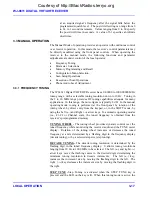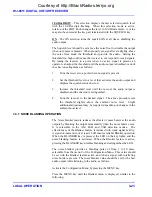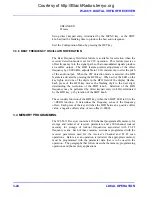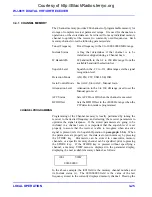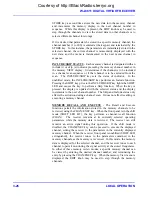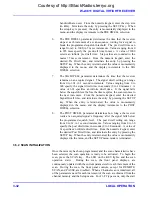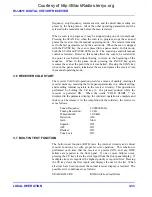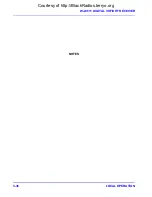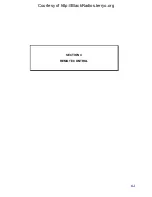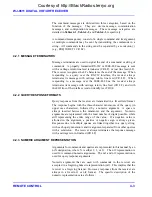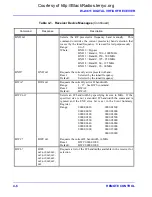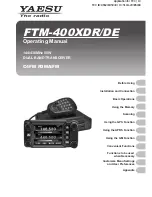
WJ-8611 DIGITAL VHF/UHF RECEIVER
3-28 LOCAL
OPERATION
Receiver. The scan type is chosen in a Scan setup menu prior to activating
the scan operation. The scan types are: Channel Scan, F1-F2 Scan, and
F1-F2 Scan with Lockouts. Before entering into one of these scan modes,
the receiver’s memory and scan menu must be programmed with the
parameters associated with the desired scan mode.
The Channel Scan mode uses parameter data stored in the receiver’s 200-
channel memory to obtain the specific receiver parameters for the channels
included in the scan sequence. It steps through the discrete frequencies
stored in each channel and stops on any frequency that has signal activity
that exceeds the specified squelch threshold level. As the receiver steps
through each channel, the stored parameters for the channel are displayed
in the front panel displays, and the receiver is set to the parameters. If a
signal is detected, the receiver stops on the signal, displays its current
tuned frequency, and activates the audio outputs for monitoring the signal
intelligence. If no active signal is found, the receiver moves to the next
channel in the sequence. When the receiver reaches the last designated
channel in the sequence, the scan restarts at the first designated channel.
The receiver parameters used by the Channel Scan are unique for each
channel in the sequence, based of the data stored in memory.
The F1-F2 Scan mode uses a Start Frequency (F1) and Stop Frequency
(F2) selected in the Scan Setup menu. In this mode, the entire spectrum
within the F1 and F2 range is searched for signal activity greater than the
specified squelch threshold level. As the scan progresses, the frequency
display is updated with the frequency at each incremental step of the scan.
If a signal is detected, the receiver stops on the signal, displays its current
tuned frequency, and activates the audio outputs for monitoring the signal
intelligence. If no signal is detected at a scan increment, the scan steps to
the next increment. When the stop frequency (F2) is reached, the scan
returns to the start and resumes scanning. In the F1 F2 scan, the receiver
parameters used for the scan are constant throughout the scan. All of the
operating parameters used by the scan are determined by their setting when
the scan is activated.
The F1-F2 with Lockouts Scan mode functions in the same manner as the
F1-F2 mode, except this mode uses the lockout data, stored in lockout
memory. This lockout data determines if the scan should stop on an
acquired signal. If a detected signal is within the bandwidth of a frequency
in lockout memory, the activity is ignored and the scan progresses to the
next increment of the scan. Using this scan function, areas in the scan
spectrum that contain signal activity of no interest can be passed over
without interfering with the scan operation.
In each of these scan types, three dwell timers are set to determine how the
timing of the scan is performed. The Pre Dwell determines how long the
scan pauses at each frequency, waiting for a signal to break threshold
before it proceeds. The Post Dwell determines how long the scan remains
on an active signal, monitoring its activity. The Post dwell determines
how long the scan remains on a frequency after the signal falls below the
threshold level. These timers are set in the Scan Setup Menu.
Courtesy of http://BlackRadios.terryo.org
Summary of Contents for WJ-8611
Page 3: ...A B blank Courtesy of http BlackRadios terryo org...
Page 4: ...THIS PAGE INTENTIONALLY LEFT BLANK Courtesy of http BlackRadios terryo org...
Page 19: ...1 i SECTION 1 GENERAL DESCRIPTION Courtesy of http BlackRadios terryo org...
Page 20: ...1 ii THIS PAGE INTENTIONALLY LEFT BLANK Courtesy of http BlackRadios terryo org...
Page 29: ...2 i SECTION 2 INSTALLATION Courtesy of http BlackRadios terryo org...
Page 30: ...2 ii THIS PAGE INTENTIONALLY LEFT BLANK Courtesy of http BlackRadios terryo org...
Page 47: ...3 i SECTION 3 LOCAL OPERATION Courtesy of http BlackRadios terryo org...
Page 48: ...3 ii THIS PAGE INTENTIONALLY LEFT BLANK Courtesy of http BlackRadios terryo org...
Page 85: ...4 i SECTION 4 REMOTE CONTROL Courtesy of http BlackRadios terryo org...
Page 86: ...4 ii THIS PAGE INTENTIONALLY LEFT BLANK Courtesy of http BlackRadios terryo org...
Page 119: ...5 i SECTION 5 CIRCUIT DESCRIPTIONS Courtesy of http BlackRadios terryo org...
Page 120: ...5 ii THIS PAGE INTENTIONALLY LEFT BLANK Courtesy of http BlackRadios terryo org...
Page 143: ...6 i SECTION 6 MAINTENANCE Courtesy of http BlackRadios terryo org...
Page 144: ...6 ii THIS PAGE INTENTIONALLY LEFT BLANK Courtesy of http BlackRadios terryo org...
Page 167: ...7 i SECTION 7 REPLACEMENT PARTS LIST Courtesy of http BlackRadios terryo org...
Page 168: ...7 ii THIS PAGE INTENTIONALLY LEFT BLANK Courtesy of http BlackRadios terryo org...
Page 243: ...A i APPENDIX A 8611 SM SIGNAL MONITOR OPTION Courtesy of http BlackRadios terryo org...
Page 244: ...A ii THIS PAGE INTENTIONALLY LEFT BLANK Courtesy of http BlackRadios terryo org...
Page 267: ...FP i FOLDOUTS Courtesy of http BlackRadios terryo org...
Page 268: ...FP ii THIS PAGE INTENTIONALLY LEFT BLANK Courtesy of http BlackRadios terryo org...
Page 298: ...Courtesy of http BlackRadios terryo org...




